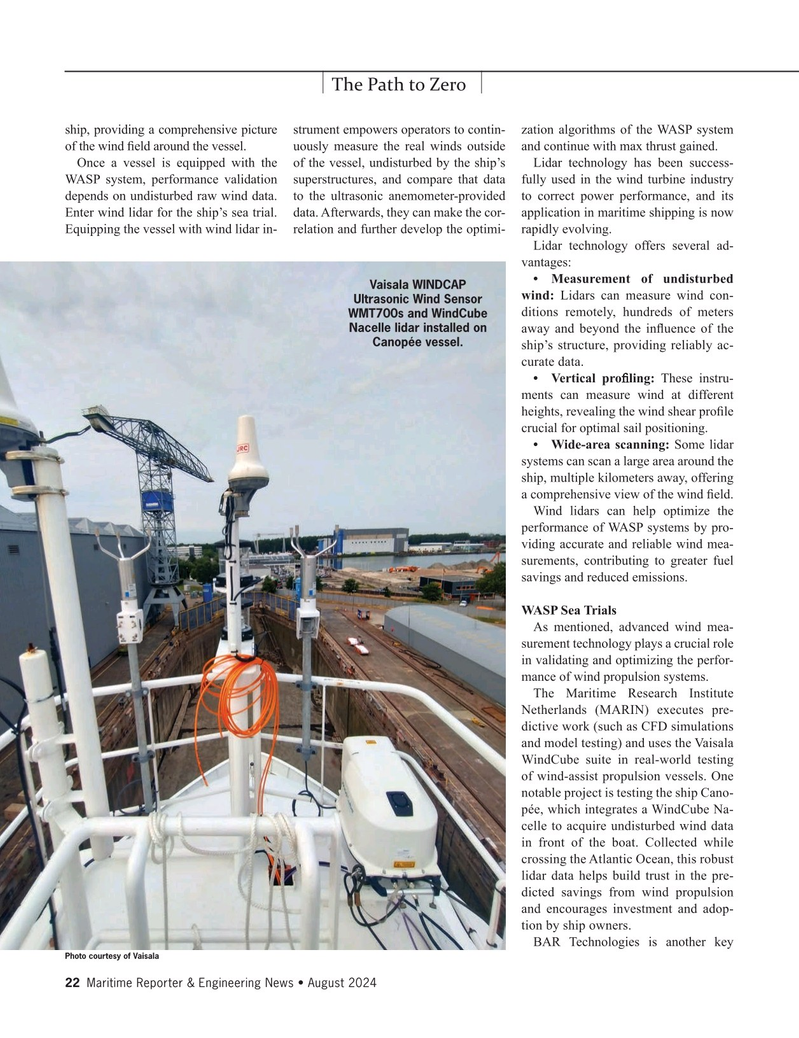
Page 22: of Maritime Reporter Magazine (August 2024)
Read this page in Pdf, Flash or Html5 edition of August 2024 Maritime Reporter Magazine
The Path to Zero ship, providing a comprehensive picture strument empowers operators to contin- zation algorithms of the WASP system of the wind ? eld around the vessel. uously measure the real winds outside and continue with max thrust gained.
Once a vessel is equipped with the of the vessel, undisturbed by the ship’s Lidar technology has been success-
WASP system, performance validation superstructures, and compare that data fully used in the wind turbine industry depends on undisturbed raw wind data. to the ultrasonic anemometer-provided to correct power performance, and its
Enter wind lidar for the ship’s sea trial. data. Afterwards, they can make the cor- application in maritime shipping is now
Equipping the vessel with wind lidar in- relation and further develop the optimi- rapidly evolving.
Lidar technology offers several ad- vantages: • Measurement of undisturbed
Vaisala WINDCAP wind: Lidars can measure wind con-
Ultrasonic Wind Sensor ditions remotely, hundreds of meters
WMT700s and WindCube
Nacelle lidar installed on away and beyond the in? uence of the
Canopée vessel. ship’s structure, providing reliably ac- curate data.
• Vertical pro? ling: These instru- ments can measure wind at different heights, revealing the wind shear pro? le crucial for optimal sail positioning.
• Wide-area scanning: Some lidar systems can scan a large area around the ship, multiple kilometers away, offering a comprehensive view of the wind ? eld.
Wind lidars can help optimize the performance of WASP systems by pro- viding accurate and reliable wind mea- surements, contributing to greater fuel savings and reduced emissions.
WASP Sea Trials
As mentioned, advanced wind mea- surement technology plays a crucial role in validating and optimizing the perfor- mance of wind propulsion systems.
The Maritime Research Institute
Netherlands (MARIN) executes pre- dictive work (such as CFD simulations and model testing) and uses the Vaisala
WindCube suite in real-world testing of wind-assist propulsion vessels. One notable project is testing the ship Cano- pée, which integrates a WindCube Na- celle to acquire undisturbed wind data in front of the boat. Collected while crossing the Atlantic Ocean, this robust lidar data helps build trust in the pre- dicted savings from wind propulsion and encourages investment and adop- tion by ship owners.
BAR Technologies is another key
Photo courtesy of Vaisala 22 Maritime Reporter & Engineering News • August 2024
MR #8 (18-33).indd 22 8/8/2024 10:29:45 AM

 21
21

 23
23
